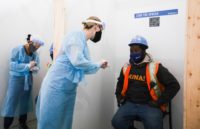The most controversial project by far is ASAP. Walker wants to increase dramatically the capacity of the pipeline. His critics say the move could jeopardize the private-sector Alaska LNG proposal backed by Exxon Mobil, Conoco Phillips and TransCanada.
However, Walker says, "It is unknown whether the producers and TransCanada will approve moving to the next phase in the face of their other competing projects worldwide." He told ENR he was considering lifting ASAP's spending freeze to study possible increased capacity. Epstein's report said the state Legislature already had appropriated over $355 million, and the pipeline had a projected cost of $7.5 billion in the current proposal.
On March 23, in a move that would limit Walker's plan to beef up ASAP, Alaska's House of Representatives passed a bill to ensure that Alaska Gasline Development Corp. maintains its commitment to the Alaska LNG project and does not embark on a duplicative, competing project "until the future of the Alaska LNG project is more certain," said Rep. Mike Chenault (R) in a press release.
This infuriated Walker, who says the state needs a backup plan if the private sector abandons Alaska LNG. He vowed to veto the bill.
Other projects need to meet engineering milestones if Alaska does not want to repay the federal dollars already spent. "Alaska would have to pay back $27 million to the Federal Highway Administration if [the Juneau Access Road] project stopped," said Jeremy Woodrow, spokesman for the Alaska Dept. of Transportation. "We're advising the governor to move forward with completing the [environmental impact review]. That would provide a reasonable stopping point for a further decision." Completing the EIR also would free the state from having to pay pack the Fed's $27 million.
So far, JAR has spent over $60 million in development and has an anticipated cost of $548 million.
Because AGC member companies such as HDR Inc., URS Corp. (now AECOM), Dowl HKM, MWH Global, Fluor and Worley Parsons have all had roles in the projects—going back 20 years, in some cases—the organization met with the governor in February to "request a seat at the table," as fiscal decisions on public-works projects are made in the capital, MacKinnon says.
"None of these projects [has] turned dirt, just paper," MacKinnon says. "But the feasibility and permitting processes are important and sometimes intense. The Susitna dam needs another $500 million to $600 million just to get through the design and permitting stages, and we represent companies performing work."
The project's permitting engineer, MWH Global, told ENR it is still optimistic about the future of the dam. "We are committed to the success of the Susitna-Watana project," said Meg VanderLaan, firm spokeswoman.
Despite a $2-billion backlog of projects, with contracts "on the street," the risk is real, MacKinnon says. "Sometimes our contractors have spent millions of dollars on these projects … they want to see them get built. They don't want to see them get held up by politics or some legal technicality."


Post a comment to this article
Report Abusive Comment